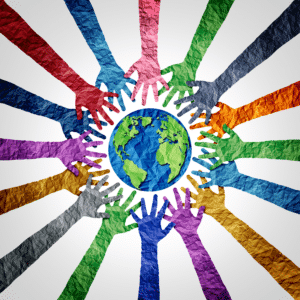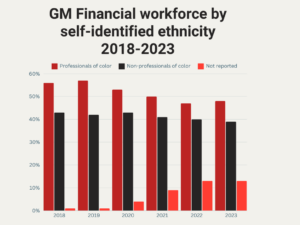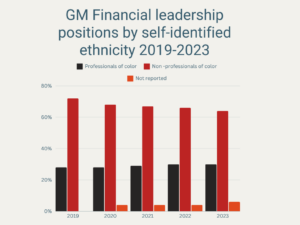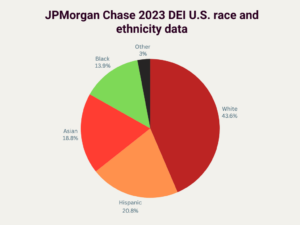DEI backlash: Auto financiers respond to social pressures
JPMorgan’s workforce was 56% non-white in 2023
Social resistance is changing some companies’ diversity, equity and inclusion strategies in a shift that is extending into the automotive space.
Even as large manufacturers such as Ford Motor Co. and Harley-Davidson scale back their programs in response to the backlash, others like Santander’s auto finance business Santander Consumer USA, Chase Auto and GM Financial are among the auto lenders that haven’t backed away from their diversity, equity and inclusion (DEI) policies.

Ford pulls back on DEI
Last week, Ford Motor Co. announced in an internal memo that it would make changes to its DEI initiatives. The memo was shared on the social media platform X, and a Ford spokesperson confirmed to Auto Finance News that the post is authentic.
The changes included:
- No longer participating in the Human Rights Campaign’s (HRC) Corporate Equality Index;
- Not applying hiring or diversity quotas for working suppliers and dealers;
- No longer commenting on polarizing issues; and
- Opening employee resource groups to all employees.
The HRC’s Corporate Equality Index is an LGBTQ+ advocacy group which listed 1,384 companies as participating in the index in a report released in November 2023. The index serves as a benchmark for how large companies are implementing LGBTQ+ inclusive policies and practices, according to the HRC website.
“We are mindful that our employees and customers hold a wide range of beliefs,” Ford Chief Executive Jim Farley said in the memo. “The external and legal environment related to political and social issues continues to evolve.”
“We are mindful that our employees and customers hold a wide range of beliefs. The external and legal environment related to political and social issues continues to evolve.” — Jim Farley, Chief Executive, Ford
Farley said the company does not “utilize hiring quotas,” nor will it use “quotas for minority dealerships and suppliers,” instead focusing on dealerships that reflect the communities they serve.
Ford declined to comment further on the changes. A company spokesperson told AFN that “the communication to our global employees speaks for itself.”
HOG, Deere and others walk back DEI
Ford joined Harley–Davidson, Tractor Supply, John Deere and Polaris Inc. in making changes to DEI initiatives following an online anti-DEI campaign led by right-wing activist Robby Starbuck, who has been vocal on social media.
Starbuck took to X on June 6, announcing: “It’s time to expose Tractor Supply,” an agricultural equipment company, targeting the company’s DEI hiring practices and hosting of LGBTQIA+ events. Like-minded activists and pundits chimed in, and Tractor Supply on June 27 announced it would eliminate all DEI roles in the company and shift away from DEI-focused goals.
Soon after, Starbuck on July 9 posted a video on X that outlined John Deere’s various DEI policies. On July 16, the company announced on X that it would no longer support or participate in social awareness events, saying that “diversity quotas and pronoun identification have never been and are not company policy.”
Harley-Davidson, after a similar campaign by Starbuck, announced on X its decision to scale back its DEI initiatives. The company said in a statement posted to X on Aug. 19 that it had not had a DEI function since April.
“We are saddened by the negativity on social media over the last few weeks, designed to divide the Harley-Davidson community,” HOG said in the statement. “As a company, we take this issue very seriously, and it is our responsibility to respond with clarity, action and facts.”
The company also opted to stop contributing to HRC’s Corporate Equality Index, according to the statement. Additionally, HOG “will no longer set spending goals for suppliers owned by minorities or women,” and the company announced that its employee training materials will now be strictly business-focused, with any “socially motivated content” removed.
The DEI shifts by Ford and HOG are companywide, affecting their captive finance companies Ford Credit and Harley-Davidson Financial Services.
Dropping ‘equity’
Many industries are facing similar pressure.
The Society for Human Resources Management (SHRM), a leading human resources membership organization, in July announced on LinkedIn a shift in how it views diversity, and has adopted the acronym “I&D,” removing “equity” from its approach to workplace diversity.
The organization announced in the post, “by emphasizing inclusion first, we aim to address the current shortcomings of DEI programs, which have led to societal backlash and increasing polarization.
“While we shift to I&D, our commitment to advancing equity remains steadfast. Equity will be integrated under the broader inclusion framework, continuing to be a priority in our strategy and leadership decisions.”
SHRM’s decision to drop “equity” from the name of its diversity program is just one example of how organizations and businesses are changing their views on workplace diversity.
A spate of bills targeting DEI initiatives in higher education came after the U.S. Supreme Court struck down affirmative action on June 29, 2023, making it illegal to consider race in college applications. At least 85 bills that limit DEI initiatives in higher education have been filed in 28 states since 2023, according to the Washington-based Chronicle of Higher Education, which covers U.S. academia.
In response, several universities have rebranded their DEI strategies and, in some cases, dropped the word “equity” from them.
Changes like these undermine progress on the bigger issues that prompted conversations around DEI in the first place. These concern the processes by which women and people of color continue to be underrepresented in the workplace, Adia Wingfield, vice dean for faculty development and diversity, and professor of sociology at Washington University in St. Louis, told AFN.
Attention to equity is important since there are patterns in workplaces that can artificially create inequities that need to be addressed, Wingfield said.
“When we talk about this issue of equity, it’s an important facet of making sure that the opportunities are available to everyone.”
The human connection
While external pressure to scale back the focus on DEI has prompted Ford and HOG to change their strategies, other auto financiers are holding steady with a targeted approach to foster diversity and inclusion in the workplace. For many, the focus on inclusion is a catalyst for maintaining diversity goals in the wake of the changing political climate.
Santander chose to focus on inclusion as the starting point with diversity being the outcome, Virnitia Dixon, Santander US chief diversity officer, told AFN. One way Santander supports a diverse workforce is by focusing on human connection and culture, which creates a sense of belonging for all employees, she said.
“We remain unassailable in the face of the societal and political climate that exists today,” Dixon said. “We have always pursued inclusion. We haven’t changed. We stay steadfast in our commitment to diversity, equity and inclusion.”
“We stay steadfast in our commitment to diversity, equity and inclusion.” — Virnitia Dixon, Chief Diversity Officer, Santander US
Santander works to create an inclusive environment with listening sessions throughout the company, she said. The sessions are departmental and invite a random selection of individuals to participate. They aren’t intended to lead to any action plans but allow employees to voice their opinions, Dixon said.
“Listening sessions afford us the opportunity to sit back outside of our engagement surveys to hear what’s on the minds of our employees,” Dixon said. “What do they have to say in their own words without responding to specific questions? That’s a way of us getting to know our employees and to create that environment where they feel like they belong.”
Read More: Beyond the metrics: The new age of DEI in auto finance
People first
Chase Auto, a business division of the JPMorgan Chase franchise has adopted a similarly people-centered approach to DEI, Renee Horne, chief marketing and customer experience officer at Chase Auto, told AFN.
“It starts with recognizing that people can be unique,” she said. “While there are homogenous needs, there are segmented needs as well. We pay attention to that, and we see people as our greatest asset, serving our employees and customers.”
While Chase follows the discourse concerning DEI, the bank’s approach to diversity remains focused on people, Horne said. “It comes back to our principles, and never losing sight of who we serve and what we’re about. If we keep those things fundamental to our culture — respect, equity and inclusion — some of these things will naturally land where they should,” Horne said.
“It comes back to our principles, and never losing sight of who we serve and what we’re about. If we keep those things fundamental to our culture — respect, equity and inclusion — some of these things will naturally land where they should.” — Renee Horne, chief marketing and customer experience officer, Chase Auto
Business resource groups
Amid the DEI backlash, employee support for diversity and inclusion remains strong, according to a survey of 3,000 workers at companies with at least 500 employees across multiple industries, published Aug. 5 by consulting and research firm Seramount.
In the survey, 76% of respondents said they are committed to fighting workplace injustice, down from 83% in 2021. At the same time, 78% of respondents said inclusion is important for an organization, but 47% said that the focus on DEI “is blown out of proportion.”
Fostering inclusion through business resource groups is one popular DEI strategy among auto finance companies. Often voluntary and employee-led, these groups seek to bring employees together through events and related activities.
Santander, for one, has seven business resource groups, according to the company. The groups help to promote leadership, find talent and offer internal support.
Chase, meanwhile, has 10 business resource groups with more than 160,000 members, according to the company. The groups have year-round programming that includes a variety of events such as keynote speakers, roundtable discussions, panels and other avenues the company offers to encourage people to chime in and feel included in the community, Horne said.
“It’s part of our DNA,” she said.
Business element to DEI
While people and inclusion are core to overarching DEI strategies, there is also a business reason for engaging with the community and embracing diversity, Alexandra Thornton, senior director of financial regulation for inclusive economy at nonpartisan think tank Center for American Progress, told AFN.
“When a company engages with the community and the community gets to know the company, this makes people more interested in reaching out to the company, trust them more and choose to do business with them,” Thornton said.
In fact, diverse organizations are 36% more likely to be profitable than less diverse companies. And companies with executive teams that have greater gender diversity are 25% more likely to outperform their competitors, according to a 2020 report by McKinsey & Co., which has conducted research on the benefits of diversity.
However, some argue that DEI studies show causation versus correlation, Center for Automotive Diversity, Inclusion & Advancement (CADIA) Chief Executive Cheryl Thompson told AFN. CADIA was launched in 2017 to focus on diversity in the automotive industry.
“Forget about all the benefits of innovation, creativity and problem solving — we’re not going to be able to find people to show up and do the jobs.” — Cheryl Thompson, CEO, CADIA
But while some doubt the effectiveness of diversity campaigns, the changing demographic of the United States makes diversifying the workforce especially important, Thompson said. She pointed to Pew Research studies that highlight the country’s changing demographics, showing that the Hispanic and Asian populations are the fastest growing.
“If we don’t diversify our workforce now, we’re not going to be able to find talent,” Thompson said.
“If we’re only fishing from one pond, that typical demographic whose population is shrinking, we’re not going to be able to have the people we need,” she said. “Forget about all the benefits of innovation, creativity and problem solving — we’re not going to be able to find people to show up and do the jobs.”
Data challenges
Tracking diversity data is important to companies looking for a better understanding of DEI metrics in their organization. However, it’s difficult to get a clear picture when much of the data relies on employees voluntarily self-reporting their identity information.
“There is a hesitancy to self-identify,” CADIA’s Thompson said.
At GM Financial, for example, 13% of employees chose not to voluntarily disclose their ethnicity in 2023, bringing down the percentage of the company’s workforce who identify as people of color, according to the company’s 2024 DEI annual report published April 24.

Although several automotive companies break out companywide DEI data, reports across auto finance reviewed by AFN did not include a non-reported percentage, as GM Financial did.
At SCUSA, the focus on human connection is one way around the challenge of self-identification, SCUSA’s Dixon said. Although some employees are skeptical about how the data may be used, the company touts the benefits of self-reporting to them, she said.
“It matters when I can look in the senior ranks and see someone who looks like me,” Dixon said. “It matters because my background is different, and the voice that I bring to the table is going to add something to the organization.”
“It matters when I can look in the senior ranks and see someone who looks like me,” Dixon said. “It matters because my background is different, and the voice that I bring to the table is going to add something to the organization.” — Virnitia Dixon, Chief Diversity Officer, Santander US
DEI data
While diversity data can be difficult to track, or fall short of providing a complete picture of an employer’s workforce, companies began tracking diversity data to ensure improved representation that aligns with the country and the community in which the business operates.
GM Financial, for one, aims to have 45% women and 35% professionals of color in senior leadership positions by 2025, according to the company’s 2024 DEI annual report. At the captive, 64% of employees in leadership positions identified as not being a person of color in 2023, while 30% of people in leadership positions said they were persons of color, according to the report.

An additional 6% of GM Financial’s employees in leadership positions chose not to report their ethnicity, which may indicate that the percentage of employees who are people of color is underrepresented, according to the DEI report.
Meanwhile, JPMorgan Chase’s U.S. workforce in 2023 was 44% white, 21% Hispanic, 19% Asian, 14% Black and 3% Other, which includes American Indian, Alaskan Native, Native Hawaiian or Other Pacific Islander, and two or more ethnicities, according to the company’s 2023 workforce composition report.

Navigating the ‘noise’
Though it is unclear where conversations concerning DEI may land or whether more auto finance companies will choose to alter — or do away with — specific DEI initiatives, it is key to look beyond DEI buzzwords to build a positive workplace culture and navigate external noise, Santander’s Dixon said.
“How we define representation matters,” Dixon said. “My personal mission in this space is to move beyond how people view DEI today and get back to what it is truly about, which is human connection.”
Auto Finance Summit, the premier industry event for auto lending and leasing, returns Oct. 7-9 at Wynn Las Vegas. To learn more about the 2024 event and register, visit www.AutoFinanceSummit.com.










